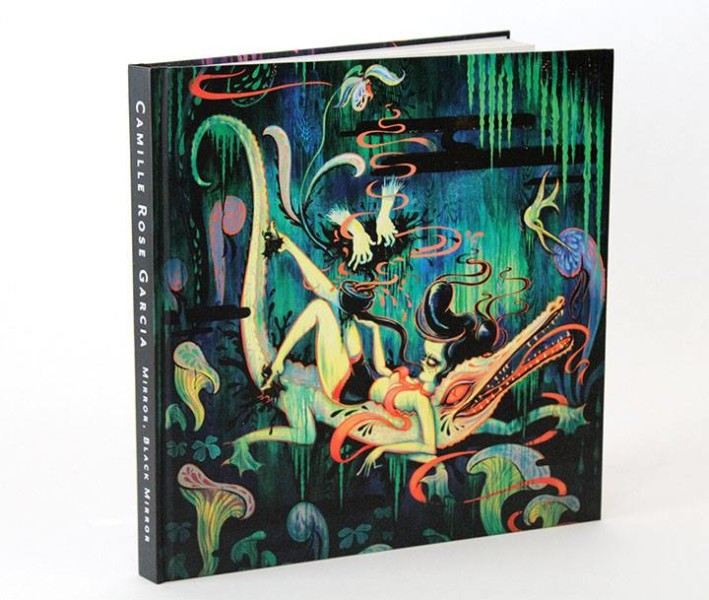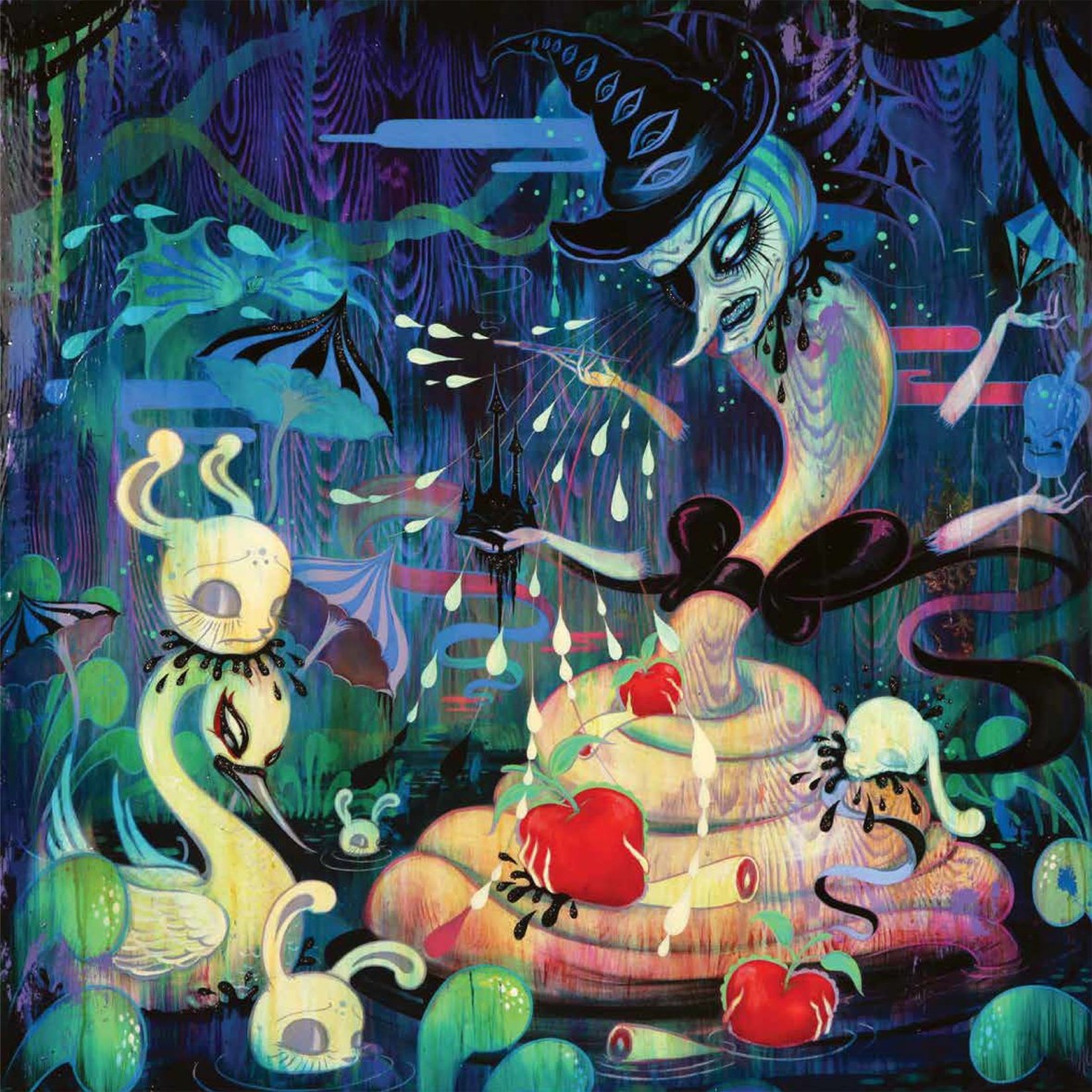In 2007, Camille Rose Garcia joined a long line of artists, writers, and musicians who have escaped to the woods, and, in turn, produced a magnum opus. A long-time favorite of the lowbrow art scene celebrated by Juxtapoz (her work has twice graced the cover), Garcia has cultivated a distinct visual presence over the past few years, embedding critiques of capitalism within lush, color-splashed canvases alive with women, animals, trees and water.
Mirror, Black Mirror ($49.95; Last Gasp), a new book chronicling Garcia’s work from 2007–2011, gathers paintings and sketches completed during the period when Garcia escaped Los Angeles for the tiny town of Gasquet, deep in the woods of Northern California. Garcia appears at the Minna Gallery on April 17 and the Schulz Museum on April 18.
As a teenager, Garcia lived in Huntington Beach, a classic SoCal beach town, surrounded by the suburbs, malls, and concrete. She escaped suburban malaise by going to Disneyland, listening to punk rock and reading Phillip K. Dick. These influences had an obvious effect on her early work, which leaned towards paintings of factories, cartoon figures, and industrial blight.

The 44-year-old artist received an MFA from UC Davis in 1994. Her work as been featured in Juxtapoz, Rolling Stone, and Modern Painter. In 2010, she created an illustrated version of Alice in Wonderland for Harper Design, which made the New York Times bestseller list and spawned two more volumes: Snow White and Cinderella.
Once she and her husband decided to go “full-immersion,” returning the woods where her back-to-the-land grandparents owned a cabin, Garcia says she started to notice color in a different way.
“After I got over my culture shock, I was suddenly completely filled up, and immersed in the magic of the natural world,” Garcia says. “Before, my work had a lot of darkness, but the palate changed to a vibrant, psychedelic color wheel.”
Garcia started to embellish her paintings with mushrooms, flowers, water, ephemera of nature that, mired in modern industrialism, she’d previously ignored. The resulting paintings are a powerful blend of the beautiful and the sinister.
But by no means has Garcia has lost her edge. The artist, whose work has been featured at the San Jose Museum and in collections at the Los Angeles County Museum of Art, still creates paintings filled with uncomfortable, nightmarish images. Women with dripping, cold eyes and claw-like hands grip pills and poison potions. Witches are mired in black oil, bearing dark gifts. Forest creatures wander lost in broken landscapes. Polar bears cradle melting icecaps. The Hydra of Babylon stealthily challenges imperialism and climate catastrophe. Snow White and the Black Lagoon uses fairytale to navigate the horrific impact of the BP oil disaster on the Gulf ecosystem.
But living so close to the natural world has undoubtedly had an impact on Garcia’s process.
“I was a little bit suspicious at first,” Garcia says. “I don’t want to be a flower painter.” At the same time, she felt compelled to move beyond a straight criticism of urban society — factories, freeways, Monsanto, and pharmaceuticals.
“I wanted it to work in the same way that Audubon would paint birds, capturing something in its essence and trying to communicate that,” she adds. “We can talk about these things in the culture that are horrible, and it’s important to bring up climate catastrophe, and that type of thing, but we also have to remember the magic that’s in the world, and in nature. It’s a whole part of our human language that we’re becoming so removed from we don’t even recognize it anymore.”

Since the beginning of her career, Garcia has delved into the mythic, and into repeating patterns, Jungian theory, and the subconscious symbolism of fairytale. Mix this with Disney and a love for the Clash, X, and other punk music, and you get Garcia’s iconoclastic narrative paintings.
“Disney is part of my whole psyche,” says Garcia. “Walt Disney was interpreting these ancient fairytales from other cultures, and those were riffing on things from Greek mythology. There are these recurring themes that go far back in history. I try to use things that we all recognize.”
For Snow White and the Black Lagoon, Garcia uses fairytale and subconscious symbols to explore man-made catastrophe. In this case, the Gulf Oil Spill. “Essentially, I’m a narrative painter, but I create a more of a dream state,” she adds. “I’m telling the tale using a structure that already exists, and that we are familiar with, but instead of white castles and the prince saving her, there are black castles everywhere, and Snow White is a Mother Earth kind of creature.”
While Garcia won’t avert her eyes from the ugliness of life, or the experience of being human (or animal) in the dysfunctional 21st century, she also wants to make paintings that people can enjoy.
“That’s why I have a little bit of the Disney thing,” she says. “You have to bring something that people can latch onto, with a little bit of hope, or beauty, or else it’s just too overwhelming. I don’t want to be so doom-and-gloom that you don’t even want to look at it.”